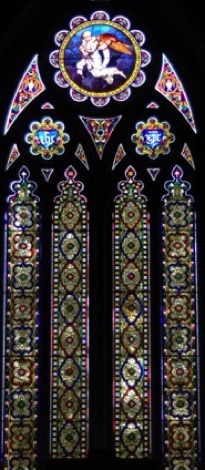by Janice O'Leary
The Boston Globe
October 29, 2006
A JIGSAW PUZZLE OF MORE THAN 4,700 PIECES -- 880 of them broken -- has been put back together, and was unveiled last weekend at Mount Auburn Cemetery.
This puzzle dates to 1845 and is the newly restored stained glass window that was removed from the cemetery's Bigelow Chapel last March. This restoration is the first in decades to reflect the window's original design.
"It showed death could be calm and noble, not scary," said Meg Winslow, the curator of special collections at the cemetery. "It's the physical embodiment of the values held by the founders. It was intended to help people contemplate the sublime."
The window also represents one of the earliest examples of stained glass work by Ballantine and Allan, a Scottish firm of painters who, at the time of the commission, had just branched out into stained glass, said restorer Roberto Rosa. "They were considered cutting edge in 1844."

That they used popular images in their work and hand painted each piece of glass was unusual, Winslow said.
She also explained how the window linked the other components of the cemetery's jigsaw puzzle. The image echoes one carved into many of the older tombstones, and its installation in the chapel connects that building to them as well.
"The building was incomplete without it, and the window was incomplete without the building," Winslow said. The gothic-style window depicts "Night," a central, white, winged female figure holding two infants, surrounded by geometric patterns. Jacob Bigelow, one of the founders of the Mount Auburn Cemetery, commissioned it from the Scottish firm, Winslow said. He turned down a religious work in favor of this popular Victorian image first created in bas relief by Danish sculptor Bertel Thorvaldsen as a metaphor for death.
Restoring the window was a difficult project, she said, "the glass was jammed in there tight." Part of the difficulty lay in uncovering the window's original pattern of glass pieces -- the last time it had been restored the pieces were fit together inaccurately, causing them to bulge and bow over time, making this puzzle even more difficult to arrange.
Winslow said the cemetery's archives supplied the documents correctly describing the window. "It's been inaccurate since the 1930s or '40s," she said.
The restorers, Serpentino Stained and Leaded Glass of Needham, removed dirt and repaired the 880 cracks to the 21-foot by 9-foot window. They also faced the task of replacing the leading between glass pieces. During the previous restoration, the lead used was too thick and applied higher than the surface of the glass.
Before beginning the restoration, Rosa and his crew did two rubbings of the window before dismantling it, one for archival purposes and the other to use as a placement guide, supplemented by Winslow's archival findings, when it was time to put it back together. They also bathed each piece in mild soap and water. "I had no idea how fragile the window was," said Winslow. "It was so obscured by dirt."
The restoration is one of the legacy projects being completed as part of Mount Auburn Cemetery's 175th anniversary celebration, which will continue through the spring of 2007. The 175-acre cemetery, created in 1831, was the nation's first landscape designed to be both a cemetery and garden open to the public. Upcoming projects include digitizing the cemetery's burial records, constructing a new visitor's center and designing the birch gardens, a new inter ment area, according to the cemetery's spokeswoman .
Fragile treasure is whole once again

